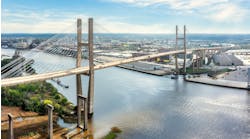By Evan Lawrence and Matt Durshimer, Contributing Authors
Functionality and safety have always been paramount in civil engineering and construction, but a strictly utilitarian approach to design can limit its ability to create connected communities.
Adapting cutting-edge technology and incorporating aesthetic elements that weave in a region’s history can elevate transportation infrastructure and enrich a city’s landscape.
The Florida Department of Transportation’s (FDOT) $171-million State Road 30 (U.S. 98) Brooks Bridge Replacement Project puts these principles into practice.
The Superior Construction-WSP design-build team will design and construct two new parallel bridges over the Santa Rosa Sound to increase capacity and improve traffic flow between Okaloosa Island and Fort Walton Beach.
Construction began in late August, and once complete, the John T. Brooks Bridge will be one of the nation's first flexible filler internal tendon spliced girder bridges. It also will relieve traffic congestion, increase the structure’s resilience, and incorporate aesthetic elements with the potential to transform a multimodal bridge into a cultural landmark.
An Improved Design
The new dual Brooks Bridges will measure 2,111 feet — 793 feet longer than the current one — and feature six travel lanes versus the current four-lane structure.
Protective barrier walls will separate the two new 12-foot-wide shared-use paths from traffic, replacing the existing narrow raised pedestrian path. The new bridges also will feature scenic overlooks and shade structures.
The structure's vertical clearance will increase from 55 to 65 feet in compliance with U.S. Coast Guard requirements. To accommodate the added height, crews will convert the existing at-grade intersection into an overpass with two new access roads to maintain existing connectivity.
“The new structure will extend past the U.S. 98/Santa Rosa Boulevard intersection, eliminating the existing traffic signal and allowing better traffic flow,” said Christ Davis, WSP’s roadway engineer of record. “New shared-use paths will be built throughout, offering improved connectivity to businesses, local parks, and community destinations.”
The project scope also includes drainage improvements, roundabout reconstruction, and intersection safety improvements at Perry Avenue, west of Fort Walton Beach, and Pier Road, east of Okaloosa Island.
Solving Site-Specific Challenges
The design-build project delivery improved FDOT’s conceptual plans by incorporating alternative technical concepts, design refinements, and construction techniques in the final design. The result: a functional, low-maintenance, and elegant structure that solves the site-specific constraints.
“We determined the existing bridge’s foundations and dolphins conflicted with the concept span arrangement, which posed a significant construction challenge,” said Christopher Vanek, WSP’s structures engineer of record.
To solve this, the team opted for a skewed 275-foot spliced girder main span unit that avoided conflicts with the existing structure. The design utilizes twin-column piers and waterline footings that are oriented parallel with the navigation channel, resulting in a 30-degree skew on the channel piers.
The flanking and approach piers are placed radially to the superstructure, improving the constructability of the simple span prestressed girders of the approach spans.
FDOT has developed new statewide design guidelines for post-tensioned construction projects that utilize flexible filler material (wax) in lieu of grout to fill the duct void and protect the strand. This will create a non-bonded tendon design for the spliced girder structure.
The new Brooks Bridge is one of the first projects in the country to use this unique system.
“To accommodate fully replaceable tendons and maintenance access, we proposed modifications to FDOT standard anchorage details that eliminated intermediate anchorages and end blocks while maintaining continuity in all tendons,” Vanek said.
The bridge foundation will use prestressed concrete piles and cast-in-place concrete. The new bridge fender system, however, will use steel pipe piles to facilitate battering, avoid subaqueous utilities, and allow low-disturbance installation with vibratory hammers.
These steel pipe piles will be coated with coal tar epoxy to provide a durable installation for the marine environment. Fiber-reinforced polymer (FRP) will be used for fender decking, walers, and other items.
Since 2013, there have been two incidents where barges struck the Brooks Bridge or its dolphins. For the new bridge, FDOT elected to design for vessel collision in accordance with American Association of State Highway and Transportation Officials (AASHTO) requirements without the use of pier protection dolphins.
Foundations are composed of 30-feet high moment capacity piles installed using predrilling and jetting techniques. This new design increases the structure’s resilience, which is especially critical since it’s an evacuation route for Okaloosa Island residents.
Site Access and Avoiding Disruptions
The project’s limited footprint demands unique solutions. A temporary trestle will deliver precast concrete materials, like piles and beams, to minimize impacts on the traveling public.
“We’re installing a temporary trestle on each bank for access, staging and delivery,” said Project Superintendent Russell Marshall. “The trestle will provide better connectivity to the work zone and will limit the use of marine equipment, crane-mounted barges, and material barges to two sub-phases during construction.”
This strategic combination of land-based and marine access points will increase effectiveness and safety during construction.
The Brooks Bridge project planning also required substantial coordination between the owner, design-build team, and 12 utility agency owners (UAO). Colby Brown, a P.E. with Greenman-Pedersen, Inc., was appointed as utility coordination manager to facilitate stakeholder communication.
“My job is to work with the UAOs to identify issues or concerns about the project design, determine how the project may affect their facilities, discuss conceptual relocation and protect-in-place plans, and work with the design-build team to make sure the facilities are accommodated throughout construction,” Brown said. “It’s critical to the public that each of these facilities remain undisturbed.”
There are numerous existing above-ground, underground, bridge-mounted, and subaqueous utilities within the project limits, including electric, gas, potable water, sanitary sewer, fiber optic, and Eglin Air Force Base's communications infrastructure.
The design-build team has accommodated each utility to ensure uninterrupted service. The new Brooks Bridge will also support bridge-mounted utilities hung within interior beams rather than exterior ones for added protection and improved aesthetics.
Since construction work — including barge spudding, temporary trestle installation, and fender pile installation — will occur within the immediate footprint of various facilities, the team is utilizing a high-accuracy survey with XYZ coordinates gathered by running probes inside the utility line itself.
As the project progresses and newly relocated utilities are finalized, as-builts will be loaded into 3D models to assist in locating newly relocated facilities within the work zone.
Meeting Environmental Commitments
The project’s 38 permitting commitments (PCs), 28 of which are the design-build team’s responsibility, indicate the owner’s dedication to environmental stewardship and stakeholder involvement.
The team proactively engaged with all regulatory agencies, including the Florida Department of Environmental Protection, the U.S. Army Corp of Engineers, and the U.S. Coast Guard.
In adherence to the PCs — which mandate protection of local smalltooth sawfish, sea turtles, gulf sturgeon, manatees, and submerged aquatic vegetation — techniques will be employed to reduce vibration from construction activities, provide erosion and settlement control, and avoid effects to the water quality. The team will also collect runoff in ponds and treat it on-site.
“We’re utilizing water trucks for dust control and employing best management practices throughout the project,” Marshall said. “We’re strategically placing tracking prevention devices at ingress and egress points to limit soil from leaving the construction site.”
As part of its hydroacoustic noise management plan, the team monitors sound thresholds from pile driving to ensure levels do not exceed 150 decibel Root Mean Square (dB RMS) beyond the predetermined radius.
To reduce effects on aquatic life and control noise, crews will employ best management practices for water-based construction, such as ramp-up procedures, added pile cushions, and bubble curtains.
In addition, nocturnal in-water pile driving will not occur from October through May to allow migratory fish to move through the area undisturbed.
The proposed roadway safety lighting incorporates dark-sky recommendations, such as downward directed, shielded and full-cutoff warm white LED fixtures. For the portions of Okaloosa Island that fall within sea turtle nesting zones, the team will install low-intensity amber-colored lighting fixtures that are wildlife-sensitive certified.
Community Enrichment
With the local beachfront community in mind, the team incorporated aesthetic features throughout the new design. The design was inspired by views of the rising and setting sun over Okaloosa Island, Choctawhatchee Bay, and Santa Rosa Sound.
“We decided a twin-column pier with custom formliners offers an open structure viewshed that still addresses bridge design requirements and site constraints,” Vanek said.
An aluminum pedestrian rail with a powder-coated finish will provide color and maximum durability. Unique shade structures will be built for each of the four overlooks. The structures will be made from galvanized and painted steel that meets the same specifications as overhead sign structures. Strategically placed aesthetic pier lighting will accentuate the formliner’s shaded areas.
The Superior-WSP team proposed a new recreational area with parking beneath the bridge. Although not a requirement, they hope it will play a vital role in fostering community for the area’s residents and visitors.
To minimize congestion, the existing bridge will remain in place through the first two construction phases. The Brooks Bridge project is expected to be completed by September 2027.
Evan Lawrence is the panhandle division manager for Superior Construction. Contact him at [email protected]. Matt Durshimer, P.E., is the design-build project manager for WSP. Contact him at [email protected].



